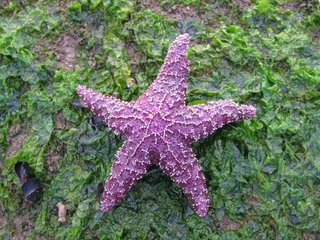
You may be saying, Beth, you have an obsession with starfish. Yes. I do. Well not really. I just like taking pictures of them, and watching them. Just think about these creatures for a second. Pretend you’ve never heard of them. Starfish are so surreal. They’re astonishing. Could you have imagined them up, had you never seen one? They’re just not logical. You couldn’t infer them from the rest of the animals you see. You couldn’t have predicted them.

I’m reading an incredible book called “Orthodoxy” by G.K. Chesterton, and it’s not about starfish, but he does say this, which I think applies (just replace “rhinoceros” with “starfish”): “It is one thing to describe an interview with a gorgon or a griffin, a creature who does not exist. It is another thing to discover that the rhinoceros does exist and then take pleasure in the fact that he looks as if he didn’t.”
Their shape is too easy, as if it were designed to be readily identifiable when seen outlined in children’s coloring books. Their color could be used to teach the same children the meaning of “purple” – it’s so well achieved. The amazing number of tiny suction-cup tube feet on their underside seems like overkill – couldn’t a few big suction cups have done it? The tiny white ossicles on their back are perfectly placed, like constellations. Constellations on a star…that’s a paradox. They glisten in the sun, leading me to believe that they’re slimy, but really they’re hard and unbendable.
They lay there, all overlapped. I think some of them are extroverted and don’t mind, but others are probably really uncomfortable touching that many other seastars and can’t wait until they can move again. Because they can’t move when they’re exposed to air – they move by a hydraulic system, using their tube feet, and when they dry out, they don’t have enough water to work the system. They’re so vulnerable in low tides, immobile, stranded, clinging to rocks, waiting to be revived by the ocean. I walk around knowing I could destroy them all if I wanted to. It doesn’t seem right that some of the most beautiful things are also the most fragile and helpless.
It’s weird to think that they’re alive, since I’ve never seen them move. They seem like part of the rock. But if you try to pry one off a rock, you see how much power they have in their suction-tube feet. They really are like aliens. They eat things by inserting their stomachs into them. They can squeeze their stomachs into a 0.1mm opening in a mussel shell. They secrete fluids to digest their food before they swallow it. They have no brain, just a nerve ring. They have a pair of sexual organs in each arm. Wow.
Listen to this… it’s so brilliant… I thought this deep thought one morning at the Rock. Ready? The stars don’t like the moon. Seriously. Think about it. The moon is responsible for the tides. When the moon pulls the tide out, it exposes the starfish, and the seagulls start pecking at them and dragging them around and eating them. Which, I assume, they don’t like. Therefore they don’t like the moon. This is logical. Although the moon also re-covers them with water. So I guess it all evens out.

2 comments:
beth, wow... i KNOW you read up on the starfish.. i had no idea they were that accessible to you there, just laying around like there's almost too many of them...and PURPLE...the only starfish i saw were tiny and orange...we took them home hard from BC..and, i love your first thoughts on the stars - again, they resonate with my own curiosity.. and guess what beth???? someone i know asked me to photograph her winter wedding!!!! seriously, so excited... dec.30th..beautiful old church, legistative buildings of regina, and a beautiful greenhouse... how awesome?? i'm so gonna get into it - looking up ideas, reading my PhotoshopCS manual..making a trip to the sites in regina... super duper!! anyway, i hope all is well with you... sounds like it.... fill me in.
love joy and peace
Soph
PS did you get my email?
beautiful as usual. I'm seriously NOT going to gasp with surprise when there is someday a book of Beth's musings. :)
have you met Catriona Day? (@ Regent) Cello player, long dark hair, BIOLOGIST. she spends her summers doing this shoreline recovery and educational thing with kids. she affectionately refers to her work as being a "beach hero". you should meet her if you haven't already.
keep those musings coming...
Post a Comment